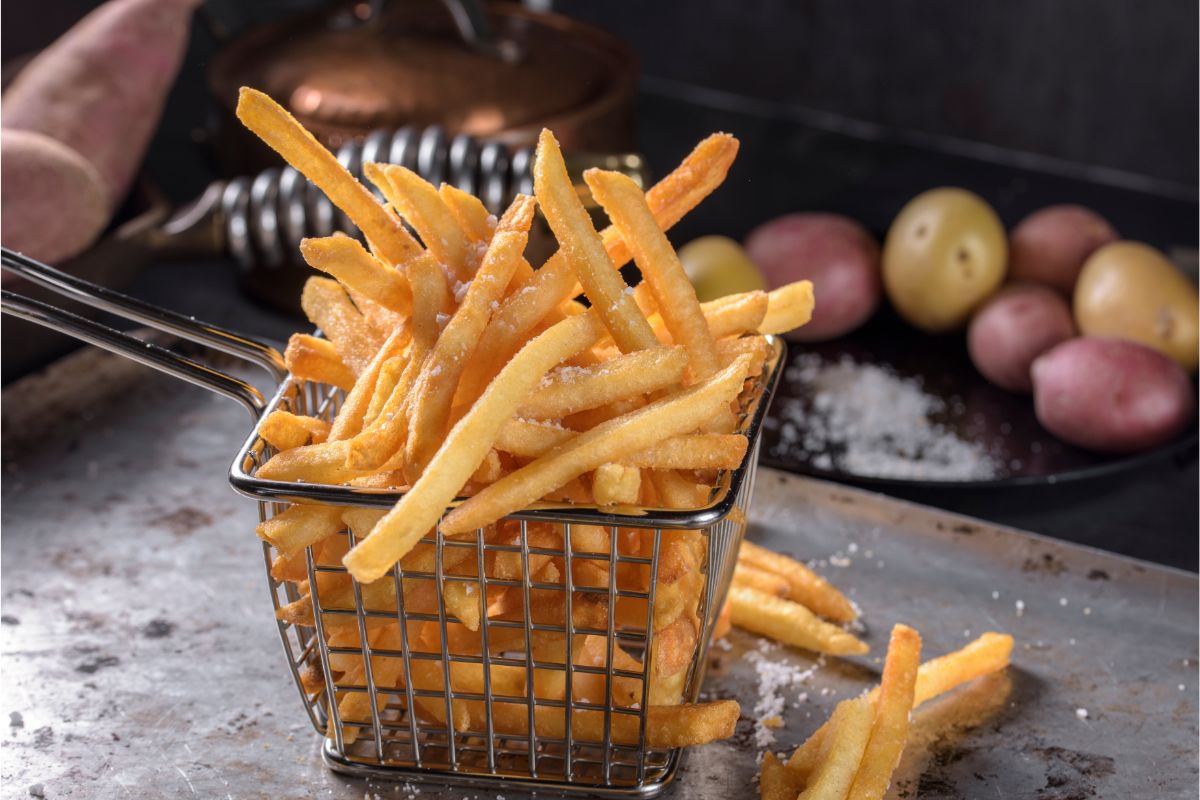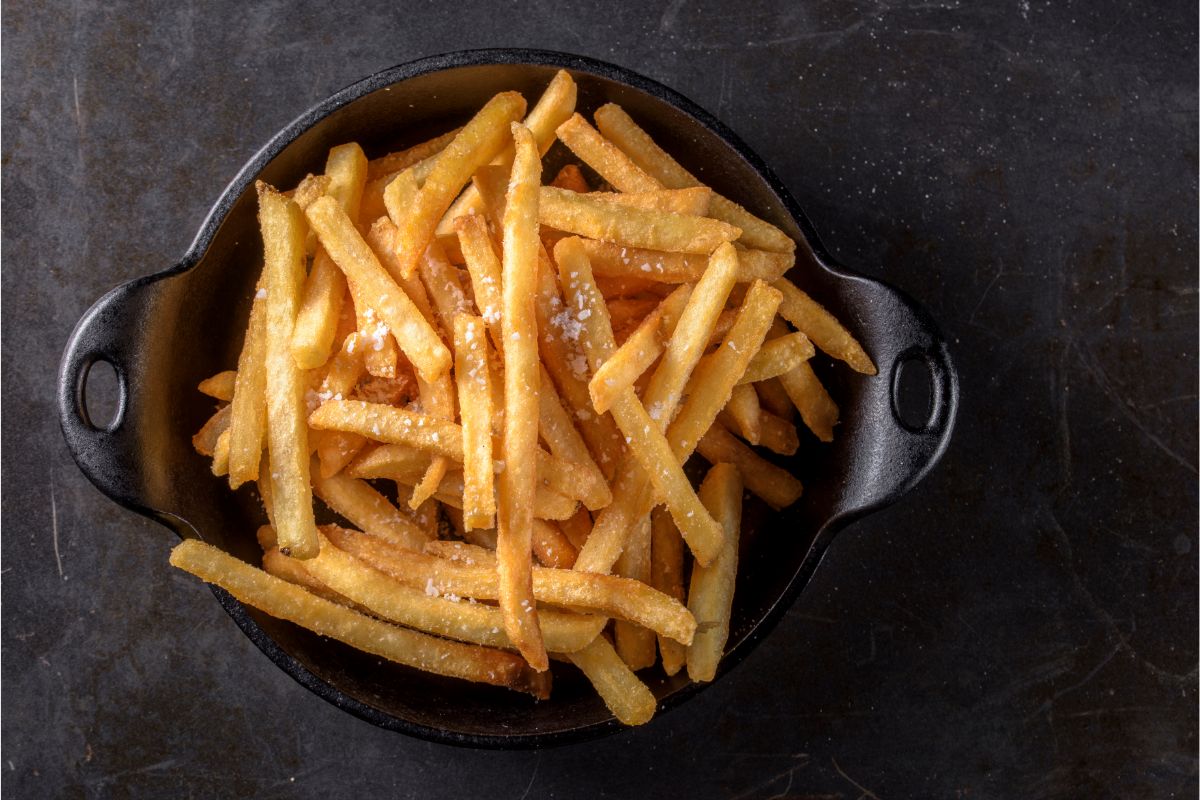French fries are a classic and beloved food item that can be enjoyed on their own or as a side dish with burgers, sandwiches, and other main courses.
While making homemade fries from scratch can be time-consuming and require some skill, using frozen french fries is a convenient and easy alternative.

However, cooking frozen fries requires some knowledge and technique to ensure they come out crispy, golden brown, and delicious.
One common method for cooking frozen french fries is deep-frying, which involves submerging the fries in hot oil until they are cooked to perfection. But how long should you deep fry frozen french fries for optimal results?
The answer depends on several factors, such as the type and thickness of the fries, the temperature of the oil, and the desired level of crispiness.
In this article, we’ll provide quick answers and tips for making perfect fries using a deep fryer or a pot of oil on the stove.
We’ll cover the recommended cooking times and temperatures for different types of frozen french fries, as well as some tricks for achieving crispy and flavorful fries every time.
Whether you’re a seasoned home cook or a novice in the kitchen, this guide will help you master the art of cooking frozen french fries to perfection.
How To Deep Fry Frozen French Fries
Deep frying frozen french fries is a quick and easy way to enjoy crispy, golden-brown fries at home. Here’s how to do it:
You’ll need:
- Frozen french fries
- Deep fryer or pot
- Vegetable oil or another frying oil
- Thermometer
- Slotted spoon or mesh skimmer
- Paper towels
- Salt or other seasonings (optional)
Instructions:
- Preheat your deep fryer or pot to the recommended temperature for the type of french fries you’re cooking. Refer to the package instructions or the guidelines provided in the previous answer for the recommended temperature and cooking time (need to adjust your cooking times? See our guide here).
- Carefully lower the frozen fries into the hot oil, making sure not to overcrowd the fryer or pot. Fry them in small batches if necessary to avoid overcrowding.
- Cook the fries for the recommended amount of time, stirring or shaking the basket frequently to ensure they cook evenly. Use a slotted spoon or mesh skimmer to remove the fries from the oil once they’re golden brown and crispy.
- Transfer the fries to a plate lined with paper towels to absorb any excess oil. Sprinkle with salt or other seasoning if desired.
- Repeat the process with the remaining batches of frozen fries, adjusting the temperature and cooking time as necessary.
- Serve the fries hot and crispy, and enjoy!
Remember to be careful when working with hot oil and to follow all safety precautions when using a deep fryer or pot. And don’t forget to dispose of the used oil properly, according to your local regulations.
Cooking Times And Oil Temperatures For Different Types Of Fries
Here are some general guidelines for cooking times and oil temperatures for different types of french fries:
- Regular cut fries: Cook at 350-375°F (180-190°C) for 3-5 minutes, or until golden brown and crispy.
- Shoestring fries: Cook at 350-375°F (180-190°C) for 2-3 minutes, or until golden brown and crispy.
- Waffle fries: Cook at 375-400°F (190-200°C) for 4-6 minutes, or until golden brown and crispy.
- Curly fries: Cook at 350-375°F (180-190°C) for 3-5 minutes, or until golden brown and crispy.
It’s important to note that these are just general guidelines, and the cooking times and oil temperatures may vary depending on the brand and thickness of the fries, as well as personal preferences.

Tips For Perfecting Your French Fries
Here are some tips for getting your fries perfect:
- Choose the right oil: The oil you use for frying can affect the taste and texture of your fries. Neutral-tasting oils with a high smoke point, such as vegetable or canola oil, are good choices.
- Use a thermometer: A thermometer is essential for ensuring that your oil is at the correct temperature. If the oil is too cool, the fries will be greasy and soggy, and if it’s too hot, they will burn.
- Don’t overcrowd the fryer: Overcrowding the fryer can cause the temperature of the oil to drop and result in unevenly cooked fries. Fry the fries in small batches, making sure not to overload the fryer.
- Dry the fries: Before frying, make sure to dry the fries thoroughly to remove any excess moisture. Wet fries will splatter in the oil and won’t get as crispy.
- Shake the basket: To ensure that the fries cook evenly, shake the basket or stir the fries frequently while cooking.
- Drain and season: Once the fries are done, remove them from the oil and drain them on paper towels to remove any excess oil. Season the fries with salt or other seasonings while they’re still hot.
- Serve immediately: French fries are best when they’re hot and crispy, so serve them immediately after cooking. If you need to hold them for a few minutes, keep them in a warm oven to maintain their crispiness.
Is A Pot Of Oil As Good As A Deep-Fat Fryer?
A pot of oil can work just as well as a deep-fat fryer for frying french fries, as long as you are careful and take the necessary precautions.
However, deep-fat fryers are designed specifically for frying and have several advantages over using a pot of oil:
- Temperature control: Deep fat fryers have built-in thermostats that allow you to control the temperature of the oil more precisely, which is important for achieving the right texture and avoiding burning the fries.
- Safety features: Many deep fat fryers have safety features, such as automatic shut-off switches and cool-touch exteriors, that make them safer to use than a pot of oil on the stove.
- Convenience: Deep-fat fryers are designed to make frying easier and more convenient. They usually have baskets or trays that make it easy to add and remove the fries, and they often have built-in filters to remove impurities from the oil.
That being said, a pot of oil can work just as well if you are careful and take the necessary precautions.
Make sure to use a pot with high sides to prevent oil from splattering, and use a thermometer to monitor the temperature of the oil. Also, never leave a pot of hot oil unattended, and make sure to dispose of the used oil properly.
Safety When Deep-Fat Frying
Deep fat frying can be dangerous if proper safety precautions are not followed. Here are some general tips for deep-fat frying safety:
- Use a deep fryer: A deep fryer is designed for deep frying and has built-in safety features such as automatic shut-off switches, temperature controls, and cool-touch exteriors that make it safer to use.
- Use a suitable pot: If you are using a pot, make sure it is deep enough to prevent oil from splattering out. A tall pot with high sides is recommended.
- Use the right oil: Use a high smoke point oil such as canola, peanut, or vegetable oil. Avoid using butter or margarine, which have a low smoke point and can catch fire.
- Monitor the temperature: Use a thermometer to monitor the temperature of the oil. The temperature should be between 350°F and 375°F (175°C and 190°C). If the oil starts to smoke, turn off the heat and allow it to cool down before continuing.
- Do not overcrowd the fryer: Do not fill the fryer or pot more than half full with oil. Overcrowding the fryer can cause the oil to overflow, which can lead to a fire.
- Be cautious when adding food: Carefully lower the food into the oil to avoid splatters. Use a basket or tongs to prevent burns.
- Keep children and pets away: Keep children and pets away from the fryer when it is in use. The hot oil can cause severe burns.
- Use a fire extinguisher: Have a fire extinguisher nearby in case of a fire. Never use water to put out an oil fire, as it can cause the fire to spread.
Final Thoughts
Cooking the perfect french fries is a culinary art form that requires a bit of knowledge and practice.
When it comes to deep frying frozen french fries, knowing the recommended cooking times and oil temperatures for different types of fries is crucial to achieving crispy and delicious results.
Additionally, following some basic tips, such as using the right oil, not overcrowding the fryer, and shaking the basket, can help you achieve the perfect texture and flavor.
Ultimately, with a little bit of practice and attention to detail, anyone can make perfect crispy french fries at home.
So next time you’re craving some fries, don’t hesitate to give it a try and see how easy and rewarding it can be to make them yourself.
- How To Reheat A Cheesesteak - November 5, 2023
- What Are Three Must Have Kitchen Knives? - September 22, 2023
- How To Protect Edges Of Pie Crust - June 15, 2023








